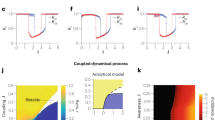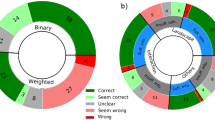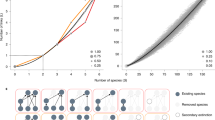Abstract
Although networks provide a powerful approach to study a large variety of ecological systems, their formulation does not typically account for multiple interaction types, interactions that vary in space and time, and interconnected systems such as networks of networks. The emergent field of ‘multilayer networks’ provides a natural framework for extending analyses of ecological systems to include such multiple layers of complexity, as it specifically allows one to differentiate and model ‘intralayer’ and ‘interlayer’ connectivity. The framework provides a set of concepts and tools that can be adapted and applied to ecology, facilitating research on high-dimensional, heterogeneous systems in nature. Here, we formally define ecological multilayer networks based on a review of previous, related approaches; illustrate their application and potential with analyses of existing data; and discuss limitations, challenges, and future applications. The integration of multilayer network theory into ecology offers largely untapped potential to investigate ecological complexity and provide new theoretical and empirical insights into the architecture and dynamics of ecological systems.
This is a preview of subscription content, access via your institution
Access options
Access Nature and 54 other Nature Portfolio journals
Get Nature+, our best-value online-access subscription
$29.99 / 30 days
cancel any time
Subscribe to this journal
Receive 12 digital issues and online access to articles
$119.00 per year
only $9.92 per issue
Buy this article
- Purchase on Springer Link
- Instant access to full article PDF
Prices may be subject to local taxes which are calculated during checkout




Similar content being viewed by others
References
Bascompte, J., Jordano, P., Melián, C. J. & Olesen, J. M. The nested assembly of plant–animal mutualistic networks. Proc. Natl Acad. Sci. USA 100, 9383–9387 (2003).
Jordano, P., Bascompte, J. & Olesen, J. M. Invariant properties in coevolutionary networks of plant–animal interactions. Ecol. Lett. 6, 69–81 (2003).
Bascompte, J. & Jordano, P. Plant–animal mutualistic networks: The architecture of biodiversity. Annu. Rev. Ecol. Evol. Syst. 38, 567–593 (2007).
Olesen, J. M., Bascompte, J., Dupont, Y. L. & Jordano, P. The modularity of pollination networks. Proc. Natl Acad. Sci. USA 104, 19891–198916 (2007).
Bascompte, J. Disentangling the web of life. Science 325, 416–419 (2009).
Ings, T. C. et al. Ecological networks–beyond food webs. J. Anim. Ecol. 78, 253–269 (2009).
Thébault, E. & Fontaine, C. Stability of ecological communities and the architecture of mutualistic and trophic networks. Science 329, 853–856 (2010).
Olesen, J. M., Stefanescu, C. & Traveset, A. Strong, long-term temporal dynamics of an ecological network. PLoS ONE 6, e26455 (2011).
Melián, C. J., Bascompte, J., Jordano, P. & Krivan, V. Diversity in a complex ecological network with two interaction types. Oikos 118, 122–130 (2009).
Fontaine, C. et al. The ecological and evolutionary implications of merging different types of networks. Ecol. Lett. 14, 1170–1181 (2011). This review discusses the importance and implications of incorporating multiple interaction types into ecological networks.
Kéfi, S. et al. More than a meal: Integrating non-feeding interactions into food webs. Ecol. Lett. 15, 291–300 (2012).
Kéfi, S., Miele, V., Wieters, E. A., Navarrete, S. A. & Berlow, E. L. How structured is the entangled bank? The surprisingly simple organization of multiplex ecological networks leads to increased persistence and resilience. PLoS Biol. 14, e1002527 (2016). This study illustrates that trophic and non-trophic interactions in a ‘node-aligned’ multiplex food web are non-randomly organized and that this organization can have important consequences for the persistence of species in a community.
Blonder, B., Wey, T. W., Dornhaus, A., James, R. & Sih, A. Temporal dynamics and network analysis. Methods Ecol. Evol. 3, 958–972 (2012).
Kivelä, M. et al. Multilayer networks. J. Complex Networks 2, 203–271 (2014). This review provides a detailed description of multilayer networks relevant diagnostics and models. It gives a starting point to learn about multilayer networks.
Boccaletti, S. et al. The structure and dynamics of multilayer networks. Phys. Rep. 544, 1–122 (2014). This review which takes a different perspective from ref. is another starting point to learn about multilayer networks.
De Domenico, M. et al. Mathematical formulation of multilayer networks. Phys. Rev. X 3, 041022 (2013).
Gilarranz, L. J., Sabatino, M., Aizen, M. & Bascompte, J. Hot spots of mutualistic networks. J. Anim. Ecol. 84, 407–413 (2014). This study illustrates that the structure of local communities in a metacommunity represented as a multilevel network is affected by the structure of the network.
Kitching, R. L. Spatial and temporal variation in food webs in water-filled treeholes. Oikos 48, 280–288 (1987).
Moore, J. C & de Ruiter, P. C. Temporal and spatial heterogeneity of trophic interactions within below-ground food webs. Agric. Ecosyst. Environ. 34, 371–397 (1991).
Schoenly, K. & Cohen, J. E. Temporal variation in food web structure: 16 empirical cases. Ecol. Monogr. 61, 267–298 (1991).
Closs, G. P. & Lake, P. S. Spatial and temporal variation in the structure of an intermittent stream food web. Ecol. Monogr. 64, 1–21 (1994).
Winemiller, K. O. in Food Webs (eds Polis, G. A. & Winemiller, K. O. ) 298–312 (Springer, 1996).
Winemiller, K. O. & Jepsen, D. B. Effects of seasonality and fish movement on tropical river food webs. J. Fish Biol. 53, 267–296 (1998).
Poisot, T. et al. The dissimilarity of species interaction networks. Ecol. Lett. 15, 1353–1361 (2012).
Carstensen, D. W., Sabatino, M., Trøjelsgaard, K. & Morellato, L. P. C. Beta diversity of plant–pollinator networks and the spatial turnover of pairwise interactions. PLoS ONE 9, e112903 (2014).
Trøjelsgaard, K., Jordano, P., Carstensen, D. W. & Olesen, J. M. Geographical variation in mutualistic networks: similarity, turnover and partner fidelity. Proc. R. Soc. B 282, 20142925 (2015).
Allesina, S. & Tang, S. Stability criteria for complex ecosystems. Nature 483, 205–208 (2012).
Rohr, R. P., Saavedra, S. & Bascompte, J. On the structural stability of mutualistic systems. Science 345, 1253497 (2014).
Bastolla, U. et al. The architecture of mutualistic networks minimizes competition and increases biodiversity. Nature 458, 1018–1020 (2009).
Olff, H. et al. Parallel ecological networks in ecosystems. Philos. Trans. R. Soc. Lond. B 364, 1755–1779 (2009).
Mougi, A. & Kondoh, M. Diversity of interaction types and ecological community stability. Science 337, 349–351 (2012).
Kéfi, S. et al. Network structure beyond food webs: Mapping non-trophic and trophic interactions on Chilean rocky shores. Ecology 96, 291–303 (2015).
Gross, K. Positive interactions among competitors can produce species-rich communities. Ecol. Lett. 11, 929–936 (2008).
Rudolf, V. H.W. & Lafferty, K. D. Stage structure alters how complexity affects stability of ecological networks. Ecol. Lett. 14, 75–79 (2011).
Pocock, M. J.O., Evans, D.M. & Memmott, J. The robustness and restoration of a network of ecological networks. Science 335, 973–977 (2012). This study describes an extensive empirical attempt to study a multilayer network that includes multiple interaction types and illustrates that considering multiple interaction types changes the robustness of a system to perturbations.
Pilosof, S. et al. Host–parasite network structure is associated with community-level immunogenetic diversity. Nat. Commun. 5, 5172 (2014).
Bauer, S. & Hoye, B. J. Migratory animals couple biodiversity and ecosystem functioning worldwide. Science 344, 1242552 (2014).
Stella, M., Andreazzi, C. S., Selakovic, S., Goudarzi, A. & Antonioni, A. Parasite spreading in spatial ecological multiplex networks. J. Complex Networks http://dx.doi.org/10.1093/comnet/cnw028(2016).
Pilosof, S., Greenbaum, G., Krasnov, B. R. & Zelnik, Y. R. Asymmetric disease dynamics in multi-host interconnected networks. Preprint at https://arxiv.org/abs/1512.09178 (2016).
Nakano, S. & Murakami, M. Reciprocal subsidies: Dynamic interdependence between terrestrial and aquatic food webs. Proc. Natl Acad. Sci. USA 98, 166–170 (2001).
Knight, T. M., McCoy, M. W., Chase, J. M., McCoy, K. A. & Holt, R. D. Trophic cascades across ecosystems. Nature 437, 880–883 (2005).
O’Neill, R. V. A Hierarchical Concept of Ecosystems (Princeton Univ. Press, 1986).
Brose, U. Body-mass constraints on foraging behaviour determine population and food-web dynamics. Funct. Ecol. 24, 28–34 (2010).
Scotti, M., Ciocchetta, F. & Jordán, F. Social and landscape effects on food webs: A multi-level network simulation model. J. Complex Networks 1, 160–182 (2013).
Porter, M. A., Onnela, J.-P. & Mucha, P. J. Communities in networks. Not. Am. Math. Soc. 56, 1082–1097, 1164–1166 (2009).
Fortunato, S. & Hric, D. Community detection in networks: A user guide. Phys. Rep. 659, 1–44 (2016).
Mucha, P. J, Richardson, T., Macon, K., Porter, M. A. & Onnela, J.-P. Community structure in time-dependent, multiscale, and multiplex networks. Science 328, 876–878 (2010).
Bazzi, M. et al. Community detection in temporal multilayer networks, with an application to correlation networks. Multiscale Model. Simul. 14, 1–41 (2016).
Bassett, D. S. et al. Dynamic reconfiguration of human brain networks during learning. Proc. Natl Acad. Sci. USA 118, 7641–7646 (2011).
Sarzynska, M., Leicht, E. A., Chowell, G. & Porter, M. A. Null models for community detection in spatially embedded, temporal networks. J. Complex Networks 4, 363–406 (2016).
Dupont, Y. L. & Olesen, J. M. Stability of modular structure in temporal cumulative plant–flower-visitor networks. Ecol. Complex. 11, 84–90 (2012).
Krasnov, B. R., Matthee, S., Lareschi, M., Korallo-Vinarskaya, N. P. & Vinarski, M. V. Co-occurrence of ectoparasites on rodent hosts: Null model analyses of data from three continents. Oikos 119, 120–128 (2010).
Pilosof, S., Fortuna, M. A., Vinarski, M. V., Korallo-Vinarskaya, N. P. & Krasnov, B. R. Temporal dynamics of direct reciprocal and indirect effects in a host–parasite network. J. Anim. Ecol. 82, 987–996 (2013).
Fortuna, M. A. et al. Nestedness versus modularity in ecological networks: Two sides of the same coin?. J. Anim. Ecol. 79, 811–817 (2010).
Holme, P. Modern temporal network theory: A colloquium. Eur. Phys. J. B 88, 1–30 (2015).
De Domenico, M., Nicosia, V., Arenas, A. & Latora, V. Structural reducibility of multilayer networks. Nat. Commun. 6, 6864 (2015).
Thébault, E. Identifying compartments in presence–absence matrices and bipartite networks: Insights into modularity measures. J. Biogeogr. 40, 759–768 (2013).
Genrich, C. M., Mello, M. A. R., Silveira, F. A. O., Bronstein, J. L. & Paglia, A. P. Duality of interaction outcomes in a plant–frugivore multilayer network. Oikos 126, 361–368 (2016).
Bassett, D. S. et al. Robust detection of dynamic community structure in networks. Chaos 23, 013142 (2013).
Martín González, A. M., Dalsgaard, B. & Olesen, J. M. Centrality measures and the importance of generalist species in pollination networks. Ecol. Complex. 7, 36–43 (2010).
Newman, M. E. J. Networks: An Introduction (Oxford Univ. Press, 2010).
Ulrich, W. & Gotelli, N. J. Null model analysis of species associations using abundance data. Ecology 91, 3384–3397 (2010).
Dormann, C. F., Fründ, J., Blüthgen, N. & Gruber, B. Indices, graphs and null models: Analyzing bipartite ecological networks. Open Ecol. J. 2, 7–24 (2009).
Flores, C. O., Poisot, T., Valverde, S. & Weitz, J. S. BiMat: A MATLAB package to facilitate the analysis of bipartite networks. Methods Ecol. Evol. 7, 127–132 (2016).
Lurgi, M., Montoya, D. & Montoya, J. M. The effects of space and diversity of interaction types on the stability of complex ecological networks. Theor. Ecol. 9, 3–13 (2016).
Craft, M. E. & Caillaud, D. Network models: An underutilized tool in wildlife epidemiology?. Interdiscip. Persp. Infect. Dis. 2011, 676949 (2011).
Lafferty, K. D. et al. Parasites in food webs: The ultimate missing links. Ecol. Lett. 11, 533–546 (2008).
Dunne, J. et al. Parasites affect food web structure primarily through increased diversity and complexity. PLoS Biol. 11, e1001579 (2013).
Selakovic, S., de Ruiter, P. C. & Heesterbeek, H. Infectious disease agents mediate interaction in food webs and ecosystems. Proc. R. Soc. B 281, 20132709 (2014).
Salehi, M. et al. Spreading processes in multilayer networks. IEEE Trans. Network Sci. Eng. . 2, 65–83 (2015).
Jordán, F. Keystone species and food webs. Philos. Trans. R. Soc. Lond. B 364, 1733–1741 (2009).
Baggio, J. A. et al. Multiplex social ecological network analysis reveals how social changes affect community robustness more than resource depletion. Proc. Natl Acad. Sci. USA 113, 13708–13713 (2016).
Miele, V., Picard, F. & Dray, S. Spatially constrained clustering of ecological networks. Methods Ecol. Evol. 5, 771–779 (2014).
Wang, Z., Andrews, M. A., Wu, Z. X., Wang, L. & Bauch. C. T. Coupled disease–behavior dynamics on complex networks: A review. Phys. Life Rev. 15, 1–29 (2015).
Miele, V. & Matias, C. Revealing the hidden structure of dynamic ecological networks. Preprint at https://arxiv.org/abs/1701.01355 (2017).
Saavedra, S., Reed-Tsochas, F. & Uzzi, B. A simple model of bipartite cooperation for ecological and organizational networks. Nature 457, 463–466 (2009).
Acknowledgements
S.P. was supported by a James S. McDonnell foundation postdoctoral fellowship for the study of complex systems and by a Fulbright postdoctoral fellowship from the US Department of State. M.A.P. was supported by the FET-Proactive project PLEXMATH (FP7-ICT-2011-8; grant no. 317614) funded by the European Commission. We thank L. G. S. Jeub for help with the analysis of multilayer modularity, M. De Domenico for insightful discussions on multilayer networks, K. Lafferty for insightful discussions on the ecology of multilayer networks, and B. R. Krasnov for help with the temporal network data. M.A.P. thanks M. Kivelä and other collaborators for helping to shape his view of multilayer networks and the participants at the first GCEE workshop on Resilience and Recovery of Biological Networks to Environmental Fluctuations for illuminating discussions.
Author information
Authors and Affiliations
Contributions
S.P. conceived the idea, performed numerical simulations, and analysed the data; M.A.P. contributed insights about the mathematics of multilayer networks and data analysis; M.P. and S.K. contributed insights on the use of multilayer networks in ecology and the interpretation of results; S.P., M.A.P., M.P., and S.K. wrote the manuscript.
Corresponding author
Ethics declarations
Competing interests
The authors declare no competing financial interests.
Supplementary information
Supplementary information
Supplementary Figures 1-6; Supplementary Tables 1–6; Supplementary Notes 1–4; Supplementary References (PDF 1670 kb)
Supplementary Data 1
Raw data for the example temporal network in the Supplementary Information (XLSX 1628 kb)
Rights and permissions
About this article
Cite this article
Pilosof, S., Porter, M., Pascual, M. et al. The multilayer nature of ecological networks. Nat Ecol Evol 1, 0101 (2017). https://doi.org/10.1038/s41559-017-0101
Received:
Accepted:
Published:
DOI: https://doi.org/10.1038/s41559-017-0101
This article is cited by
-
Motif-based community detection in heterogeneous multilayer networks
Scientific Reports (2024)
-
Ecological network analysis reveals complex responses of tree species life stage interactions to stand variables
Journal of Forestry Research (2024)
-
More is different in real-world multilayer networks
Nature Physics (2023)
-
Dynamics of species-rich predator–prey networks and seasonal alternations of core species
Nature Ecology & Evolution (2023)
-
Predicting cascading extinctions and efficient restoration strategies in plant–pollinator networks via generalized positive feedback loops
Scientific Reports (2023)



